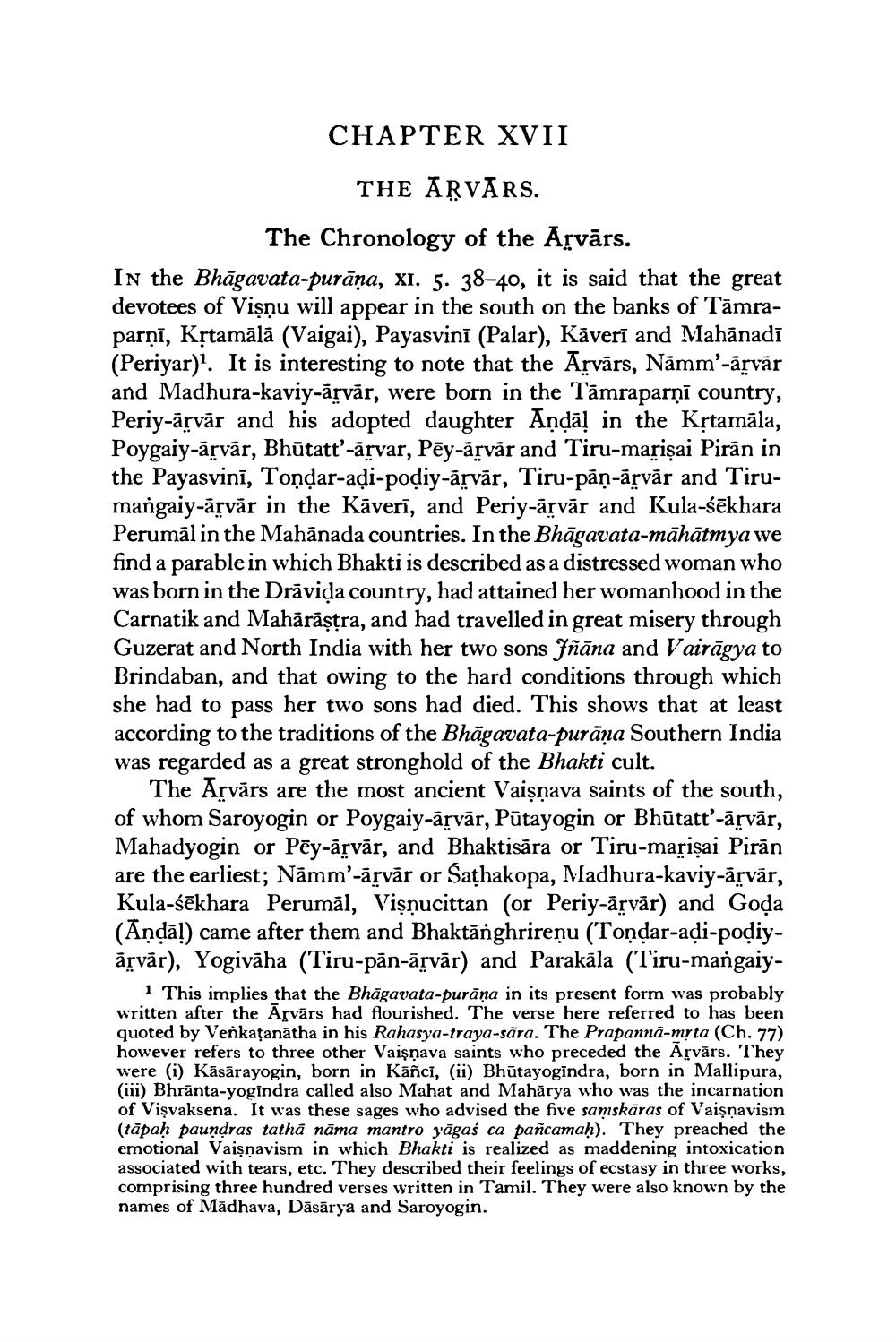________________
CHAPTER XVII
THE ĀRVĀRS.
The Chronology of the Apvārs. In the Bhāgavata-purāņa, xi. 5. 38-40, it is said that the great devotees of Vişņu will appear in the south on the banks of Tāmraparṇī, Krtamālā (Vaigai), Payasvinī (Palar), Kāverī and Mahānadi (Periyar)". It is interesting to note that the Arvārs, Nămm'-ārvār and Madhura-kaviy-ārvār, were born in the Tāmraparņi country, Periy-ārvār and his adopted daughter Andāļ in the Krtamāla, Poygaiy-ārvār, Bhūtatt'-ārvar, Pēy-ārvār and Tiru-marișai Pirān in the Payasvinī, Tondar-aţi-podiy-ārvār, Tiru-pāņ-ārvār and Tirumangaiy-arvăr in the Kāverī, and Periy-ārvār and Kula-śēkhara Perumal in the Mahānada countries. In the Bhāgavata-māhātmya we find a parable in which Bhakti is described as a distressed woman who was born in the Drāvida country, had attained her womanhood in the Carnatik and Mahārāștra, and had travelled in great misery through Guzerat and North India with her two sons Jñāna and Vairāgya to Brindaban, and that owing to the hard conditions through which she had to pass her two sons had died. This shows that at least according to the traditions of the Bhāgavata-purāņa Southern India was regarded as a great stronghold of the Bhakti cult.
The Arvārs are the most ancient Vaişnava saints of the south, of whom Saroyogin or Poygaiy-ārvār, Pūtayogin or Bhūtatt'-ārvār, Mahadyogin or Pēy-ārvār, and Bhaktisāra or Tiru-marisai Pirān are the earliest; Nămm'-ārvār or Sathakopa, Madhura-kaviy-ārvār, Kula-śēkhara Perumal, Visnucittan (or Periy-ārvār) and Goda (Andā!) came after them and Bhaktārghrireņu (Tondar-adi-podiyārvár), Yogivāha (Tiru-pān-ārvār) and Parakāla (Tiru-mangaiy
1 This implies that the Bhāgavata-purāņa in its present form was probably written after the Arvārs had flourished. The verse here referred to has been quoted by Venkatanātha in his Rahasya-traya-sära. The Prapannā-mrta (Ch. 77) however refers to three other Vaisnava saints who preceded the Arvārs. They were (i) Kāsārayogin, born in Kāñci, (ii) Bhūtayogindra, born in Mallipura, (iii) Bhrānta-yogindra called also Mahat and Mahārya who was the incarnation of Vişvaksena. It was these sages who advised the five samskāras of Vaişnavism (tāpaḥ paundras tathā nāma mantro yāgaś ca pañcamah). They preached the emotional Vaisnavism in which Bhakti is realized as maddening intoxication associated with tears, etc. They described their feelings of ecstasy in three works, comprising three hundred verses written in Tamil. They were also known by the names of Mādhava, Dāsārya and Saroyogin.




